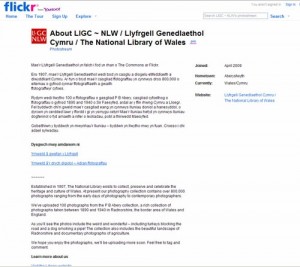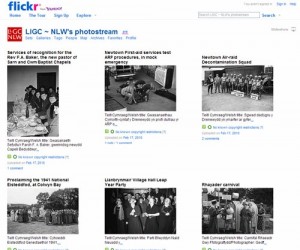The National Library of Wales and Flickr Commons
Posted by guestblogger on July 26th, 2010
About this guest blog post
Siân Lloyd Pugh is e-Editor at the National Library of Wales. She is responsible for the Library’s online content, ranging from the Library’s website to all web 2.0 provisions. She also monitors all the Library’s online statistics and trains all online contributors.
Siân can be contacted at sle@llgc.org.uk
The National Library of Wales and Flickr Commons
Background
The National Library of Wales joined Flickr Commons in April 2009. Originally the Library joined as a pilot, which was a part of the Web 2.0 research undertaken by Dr Paul Bevan, leading to the new NLW web strategy. This has been a highly successful and popular pilot, and the work is now seen as an integral part of the Library’s provision.
The Library sought to join Flickr Commons as a way to open its collections to a wider audience. The Library has a powerful online catalogue that allows users to search and view digital images online, but of course if you don’t know that items exist it’s hard to find them in a catalogue. Flickr Commons therefore was the perfect way to bring these collections to the attention of interested parties, that may not think to visit the National Library of Wales’ website, let alone its catalogue.
Roles and Responsibilities
Early on in the project it was recognised that we needed to clearly define roles and responsibilities in order to ensure the smooth running of the account.
Image Selection
It was decided that the images should be selected and uploaded by a member of staff in the digitisation section, as they are aware which photographic collections have been digitised.
Content monitoring and Interaction
The content monitoring and interaction work was undertaken by the exhibitions interpretation officer. At the time Flickr Commons was seen as a sort of online exhibition space where we could share copyright free photographs from the collection, which is why the moderation and responding to comments work was placed in the exhibitions unit. However, a new member of staff joined the marketing unit at the end of last year, responsible for the day to day running of much of our online web 2.0 provision, and so this work was moved to this post.
It was felt that it was important to keep all day to day running of our web 2.0 provision together, and Flickr Commons is an important part of this. This move means that we can easily highlight new photographs on Twitter or write a comment on Facebook about interest in certain photographs etc. We feel it’s vitally important that we join our web 2.0 presence together, while keeping in mind that all outlets are different and have different audiences and this must be respected in order to fulfil each medium’s potential.
Strategic development
As e-Editor I oversee the day to day running of the account, and I am also responsible for the statistical analysis of the data. I am also the first port of call if any problems arise with comments, questions regarding Flickrmail enquiries etc. Finally, I am responsible for driving the project forward strategically, and ensuring that we continue to fulfil our users’ expectations.
Future Development
As I mentioned, we are continually trying to ensure that we develop our web 2.0 presences, Flickr Commons included. We recently held a meeting to discuss our current Flickr presence, and whether we felt it was worth pursuing, and it was a resounding yes from everyone!
The level of interest we’ve had in the profile has been incredible, something we could never have achieved if the photographs were left in the catalogue and on some NLW microsites alone. Our statistics tend to speak for themselves. 45% of our images have received comments, and 72% have been selected as favourites. These statistics clearly show the value for money the project offers. It costs very little to run the account, but it’s incredibly popular. It also affords us the opportunity to reach users who we could never have hoped to reach otherwise.
1. Engaging with ours users
One area that is very important to us to develop in the future is the interaction between the Library and its users. We want to be a living Library that people can connect with, not a quiet establishment to admire from afar.
Designating a member of staff to moderate (although we haven’t really had any issues with moderation) and interact with users, by responding to comments and accepting request to add images to groups is very important therefore. We hope that as our collection on Flickr Commons grows, that this interaction will also develop. Although it must be recognised that it’s impossible to respond to all comments as we receive so many!
2. Upload API
We currently upload all images by hand, but we are looking at the possibility of developing and API to upload selected images automatically. Although Flickr is very user friendly and easy to use, uploading every image takes time, and developing an API to take images from our catalogue and upload them directly into Flickr will make this work much quicker.
3. A cohesive presence
As the content moderation and interaction work now lies in the promotions unit, we also hope to tie the selected images from the digitisation section much more closely with current exhibitions and events that the Library is involved with. This has a twofold benefit. It makes the images more relevant, and hopefully will entice those users who are in a position to do so, to visit exhibitions. It also brings the work of selecting and uploading images much closer to the work of managing the content then generated, thus giving us a more cohesive presence on Flickr Commons.
Who know what the future holds?
In the long term of course, the possibilities are vast.
Currently only very few of our photographs are geotagged, but this functionality certainly offers some very interesting possibilities for the future. One other aspect that we are baring in mind is crowdsourcing. A few of our users on Flickr Commons add additional tags to our photographs, and the notion of being able to crowdsource these and add them to our online catalogue could be very interesting indeed.
Happy, but keeping one eye on the horizon
But for now, we are content with trying to grow our audience
on Flickr Commons, by continuing to add interesting photographs from our collection, and cross-pollinating through our various online presences.
As I mentioned, our original aim in joining Flickr Commons was just to open our photographic collection to the world, and help people enjoy the treasures that we hold – and judging from the response, I think we can certainly say that Flickr Commons has been a roaring success.



July 26th, 2010 at 11:58 am
[...] This post was mentioned on Twitter by Claire, Sally Cummings. Sally Cummings said: RT @SmilyLibrarian RT @calire Blog post about the National Library of Wales and Flickr Commons http://ow.ly/2guri [...]
October 12th, 2010 at 3:05 pm
Following my guest post here, I’ve published a short post on the National Library of Wales blog discussing the kind of interactions the Library has seen on our Flickr Commons images – http://nlwales.blogspot.com/2010/10/want-informationask-flickr-commons.html
We also have a guest Q&A with one of our Flickr Commons users who has used one of our images to create a pair of shoes! http://nlwales.blogspot.com/2010/10/national-library-of-wales-flickr.html
March 16th, 2011 at 10:44 am
[...] (a Renaissance East Midlands project) to Using a Blog as a Research Diary (by a PhD student), The National Library of Wales and Flickr Commons and Archives [...]